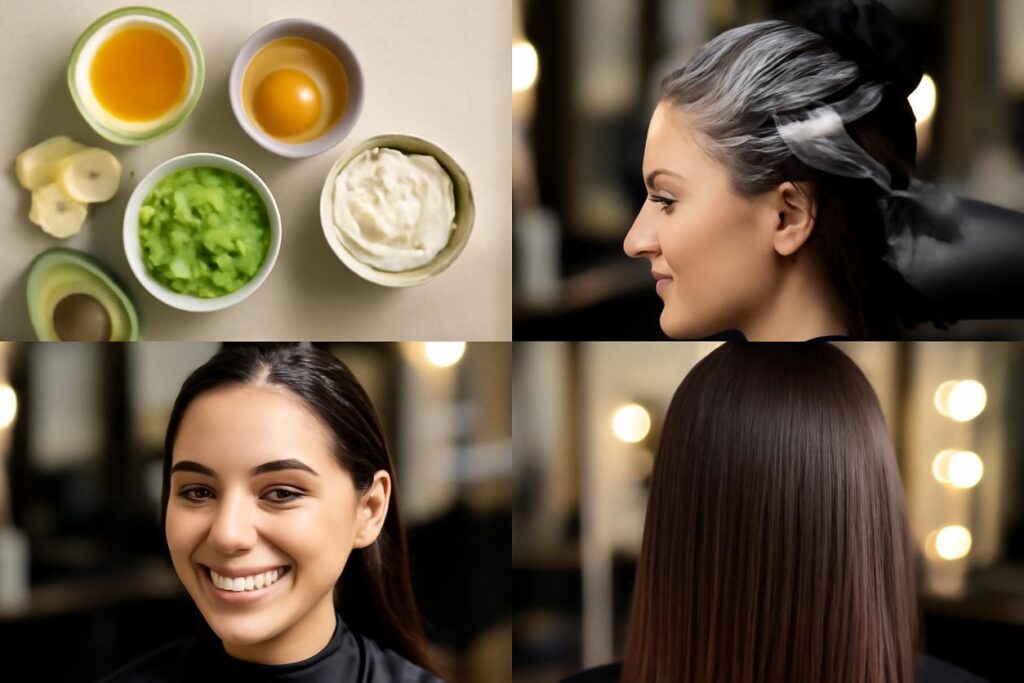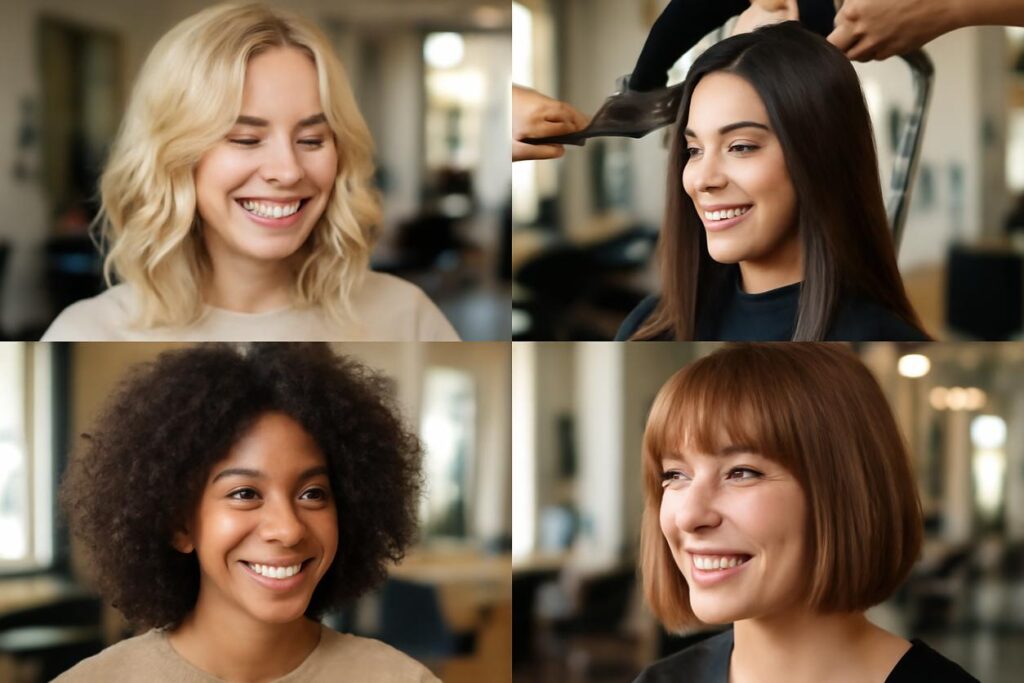Table of Contents
- Introduction: Why Your Nighttime Routine is Your Hair’s Best Friend
- How Hair Actually Repairs Itself Overnight
- Preparing Your Hair Before Bed: A Quick Checklist
- Protective Sleeping Styles for Every Hair Texture
- The Best Fabrics and Tools for Ultimate Sleep Protection
- Overnight Treatments Explained: Potions for Your Pillow Time
- Five Simple DIY Overnight Masks from Your Pantry
- Weekly Overnight Hair Care Templates for Your Goals
- How to Track Your Progress and See Real Results
- Troubleshooting: Common Overnight Hair Issues and Their Fixes
- When to Seek Professional Advice
- Summary and Your Seven-Night Action Plan
Introduction: Why Your Nighttime Routine is Your Hair’s Best Friend
What if you could transform your hair from frizzy, dry, or damaged to smooth, hydrated, and strong—all while you sleep? It sounds like a dream, but it’s the reality of a strategic overnight hair care routine. We often focus so much on our daytime styling, but the 6 to 8 hours we spend sleeping present a golden opportunity for hair repair and protection. Tossing and turning on a standard cotton pillowcase can cause friction, leading to breakage, split ends, and tangles. Your nighttime routine is not just about preventing damage; it’s about actively improving your hair’s health, making your mornings easier and your hair happier in the long run.
This guide is designed for everyone, from complete beginners to hair care enthusiasts. We’ll break down the science, provide step-by-step instructions, and even give you a seven-night plan to kickstart your journey. Get ready to wake up to your best hair day, every day, starting in 2025 and beyond.
How Hair Actually Repairs Itself Overnight
Just like your skin and body, your hair and scalp enter a regenerative phase while you sleep. During deep sleep, your body increases blood flow to the hair follicles, delivering essential oxygen and nutrients that are vital for healthy growth. Additionally, stress hormone (cortisol) levels decrease, while growth-related hormones peak.
This natural biological process creates the perfect environment for treatments to work their magic. When you apply a nourishing mask or serum as part of your overnight hair care, you’re giving your hair an uninterrupted period to absorb the benefits, free from environmental stressors like UV rays and pollution. By working *with* your body’s natural cycle, you can significantly accelerate your hair health goals.
Preparing Your Hair Before Bed: A Quick Checklist
A few minutes of prep can make all the difference between waking up to a tangled mess and smooth, manageable locks. Think of it as the foundation of your entire overnight hair care system.
- Detangle Gently: Always remove knots before bed. Start from the ends and work your way up to the roots using a wide-tooth comb or your fingers. This prevents minor tangles from becoming major breakage overnight.
- Ensure Hair is Mostly Dry: Sleeping with soaking wet hair can be damaging, as hair is at its most fragile state when wet. If you wash your hair at night, allow it to air-dry at least 80% of the way or use a diffuser on a low, cool setting. Slightly damp hair is okay for setting braids or twists.
- Apply Leave-In Products (If Needed): If your hair is dry, apply a small amount of a lightweight leave-in conditioner or a few drops of a sealing oil to your mid-lengths and ends. This provides a continuous dose of moisture.
Protective Sleeping Styles for Every Hair Texture
The goal of a protective style is to minimize friction, prevent tangles, and preserve your hair’s natural texture or style. The right style depends heavily on your hair type.
For Straight to Wavy Hair (Type 1-2)
The main goal here is to prevent tangles and unwanted kinks.
- The Loose Braid: A classic for a reason. A single, loose braid down your back prevents tangling and can create soft, uniform waves by morning.
- The Low Ponytail: Secure a loose ponytail at the nape of your neck with a soft scrunchie. Avoid tight elastics that can cause breakage.
- The Top Knot or “Pineapple”: If you have wavy hair and want to preserve volume, gathering your hair into a very loose bun or ponytail on the top of your head (the “pineapple”) works wonders.
For Curly Hair (Type 3)
Curls need protection to maintain their pattern and avoid frizz.
- The Pineapple: This is a curly-hair staple. Gather your curls into a high, loose ponytail on top of your head to protect the curl clumps from being crushed while you sleep.
- Multi-Pineapples: For shorter curly hair, you can create two or three smaller, loose ponytails to achieve the same effect.
- The Medusa Clip: Use several small claw clips to secure sections of curls on top of your head. This method is excellent for preserving your curl pattern without stretching it out.
For Coily or Kinky Hair (Type 4)
The focus for coily hair is on moisture retention and preventing shrinkage and tangles.
- Twists or Braids: Sectioning your hair into several twists or braids is a fantastic way to protect it, lock in moisture, and create a defined texture for the next day.
- Bantu Knots: This style involves creating small, coiled buns around your head. It’s a powerful way to protect your ends and stretch your hair simultaneously.
The Best Fabrics and Tools for Ultimate Sleep Protection
Your hairstyle is only half the battle. The surfaces your hair touches are just as important.
Silk and Satin: Your Hair’s Best Friends
Cotton pillowcases are highly absorbent, meaning they can sap moisture from your hair, leaving it dry and brittle. They also have a rougher texture that creates friction. Silk and satin are superior choices because their smooth surfaces allow your hair to glide across them, reducing friction, breakage, and frizz. Silk is a natural fiber, while satin is a weave, but both offer significant benefits over cotton.
Pillowcases, Bonnets, and Scarves
Choosing between these comes down to personal preference and your hairstyle.
- Pillowcases: A silk or satin pillowcase is the easiest swap. It’s great for anyone and especially helpful if you find bonnets or scarves uncomfortable or if they tend to slip off.
- Bonnets: A satin-lined bonnet is excellent for containing voluminous hair, preserving complex styles like twists or Bantu knots, and maximizing moisture retention for very dry or curly/coily hair types.
- Scarves: A silk or satin scarf can be tied around your hair to keep a style in place (like a “pineapple”) or to protect your edges. It offers a more secure fit than a bonnet for some people.
Overnight Treatments Explained: Potions for Your Pillow Time
An overnight hair care routine is the perfect time to use intensive treatments, as the extended contact time allows for maximum penetration and absorption. These treatments generally fall into a few categories.
Oils, Serums, and Masks
- Hair Oils: Oils like argan, jojoba, or coconut oil are great for sealing the hair cuticle to lock in moisture and reduce frizz. They are best applied sparingly to the mid-lengths and ends to avoid weighing hair down.
- Serums: These are typically lightweight, concentrated formulas designed to target specific issues like breakage or dullness. They penetrate the hair shaft more deeply than oils.
- Overnight Masks: These are deep conditioners designed to be left on for several hours. They provide an intense dose of hydration and nutrients. Many DIY options are incredibly effective.
Five Simple DIY Overnight Masks from Your Pantry
You don’t need expensive products to start a powerful overnight hair care regimen. Your kitchen holds the key to healthier hair. Apply these masks to damp hair, cover with a shower cap, and wash out in the morning.
| Mask Name | Ingredients | Best For | Instructions |
|---|---|---|---|
| Hydrating Aloe and Honey | 2 tbsp Aloe Vera Gel, 1 tbsp Honey | Dryness and Scalp Health | Mix well and apply from root to tip. The humectant properties of honey and the hydration from aloe work to draw in moisture. |
| Strengthening Coconut Oil | 2-3 tbsp melted Coconut Oil | Weak, Brittle Hair | Apply to the length of your hair, focusing on the ends. Studies show coconut oil can reduce protein loss from hair. |
| Frizz-Taming Avocado and Olive Oil | 1/2 ripe Avocado, 2 tbsp Olive Oil | Frizz and Unruliness | Mash the avocado until smooth and mix in the olive oil. The healthy fats coat the hair shaft, smoothing it down. |
| Shine-Boosting Yogurt | 3 tbsp plain Greek Yogurt | Dullness and Buildup | Apply the yogurt thoroughly. The lactic acid helps to gently cleanse the scalp and hair, while the fats add moisture and shine. |
| Scalp-Soothing Green Tea | 1 cup brewed and cooled Green Tea | Irritated or Oily Scalp | After detangling, pour the green tea over your scalp and hair. The antioxidants can help soothe the scalp. Let it sit for the night. |
Weekly Overnight Hair Care Templates for Your Goals
Consistency is key. Here are some sample weekly routines you can adapt for 2025 and beyond.
Goal: Maximum Moisture (for Dry or Curly Hair)
- Sunday: Apply a DIY hydrating mask overnight.
- Monday: Sleep in a protective style (pineapple/twists) with a satin bonnet.
- Tuesday: Spritz ends lightly with water and seal with a few drops of oil before bed.
- Wednesday: Rest day (protective style only).
- Thursday: Apply a lightweight leave-in conditioner to ends.
- Friday/Saturday: Rest days (protective style only).
Goal: Damage Repair (for Processed or Brittle Hair)
- Sunday: Apply the strengthening coconut oil treatment overnight.
- Monday/Tuesday: Rest days with a loose braid and silk pillowcase to minimize mechanical stress.
- Wednesday: Apply a bond-repairing serum to ends before bed.
- Thursday/Friday/Saturday: Rest days focusing on gentle protective styling.
How to Track Your Progress and See Real Results
How do you know if your new overnight hair care routine is working? Look for tangible changes.
Create a Simple Hair Diary
For a few weeks, jot down what you did each night and how your hair felt and looked the next morning. This helps you identify what your hair loves.
Key Performance Indicators (KPIs) for Your Hair
- Morning Frizz Level: Is your “halo” of frizz reduced?
- Softness and Texture: Does your hair feel softer and less straw-like?
- Ease of Detangling: Are your morning brush-throughs getting easier with fewer knots?
- Breakage Check: Do you see fewer broken strands on your pillow or in your brush?
- Shine Factor: Does your hair have more natural luster and reflectivity?
Troubleshooting: Common Overnight Hair Issues and Their Fixes
“My hair feels greasy in the morning!”
The Fix: You might be using too much product or applying it too close to your roots. Focus oils and heavy creams on the last few inches of your hair. Opt for lighter formulas if you have fine hair.
“My bonnet or scarf always falls off!”
The Fix: Try a bonnet with an adjustable band for a more secure fit. For scarves, tying them in a different configuration or using a few bobby pins to secure them can help. A silk pillowcase is a great backup plan.
“My hair is still frizzy when I wake up!”
The Fix: Ensure your hair is not too damp when you go to bed. Re-evaluate your protective style—it might not be secure enough. Finally, make sure your silk/satin bonnet or pillowcase is in good condition; a worn-out fabric can lose its smoothness.
When to Seek Professional Advice
While a great overnight hair care routine can solve many common problems, some issues require an expert. If you experience persistent, severe scalp itching or flaking, a sudden increase in hair loss, or breakage that doesn’t improve with gentle care, it’s time to consult a dermatologist or a certified trichologist. They can diagnose underlying conditions and recommend targeted treatments.
Summary and Your Seven-Night Action Plan
Embracing overnight hair care is about shifting your perspective: your sleep time is productive repair time. By protecting your hair from friction, providing it with sustained nourishment, and being consistent, you can make a dramatic impact on its health and appearance. It’s a simple, low-effort investment with a high reward.
Your First Week: The 7-Night Trial Plan
Use this plan to ease into your new routine and discover what works for you.
| Night | Action | Morning Observation |
|---|---|---|
| Night 1 | Baseline: Sleep with your hair in a loose braid or pineapple on your regular pillowcase. | Note the level of frizz, tangles, and overall feel. This is your starting point. |
| Night 2 | Introduce Protection: Use the same hairstyle but add a silk/satin pillowcase or bonnet. | Compare the frizz and smoothness to Day 1. Is there less friction-induced mess? |
| Night 3 | Add Light Moisture: Apply 2-3 drops of a light oil (like argan or jojoba) to your ends before styling. | Do your ends feel softer and more sealed? |
| Night 4 | Rest: Go back to just your protective style and silk/satin surface. | Observe how your hair holds onto the moisture from the previous night. |
| Night 5 | Deep Treatment: Choose one DIY mask from the list above that suits your hair goal. Apply and sleep with it. | After rinsing, assess the immediate impact on softness, shine, and hydration. |
| Night 6 | Rest: Let your hair enjoy the benefits of the mask. Just use a protective style. | How does your hair feel a day after the treatment? |
| Night 7 | Assess and Plan: Look back at your notes. What made the biggest difference? | Use your observations to build your personalized weekly routine for the future. |
Start tonight. Your journey to waking up with healthier, more beautiful hair is just one sleep away.






